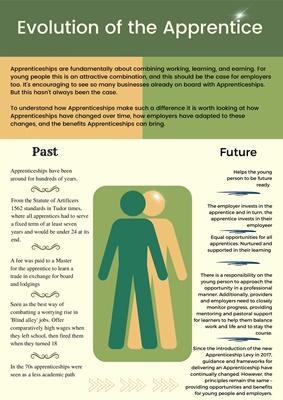
Evolution of the Apprentice
There is a responsibility on the
young person to approach the
opportunity in a professional
manner. Additionally, providers
and employers need to closely
monitor progress, providing
mentoring and pastoral support
for learners to help them balance
work and life and to stay the
course.
Helps the young
person to be future
ready
Equal opportunities for all
apprentices. Nurtured and
supported in their learning
Future
The employer invests in the
apprentice in turn, the apprentice
invests in their employeer
The introduction of the new
Apprenticeship Levy in 2017,
guidance and frameworks for
delivering an Apprenticeship have
continually changed. However, the
principles remain the same -
providing opportunities and benefits
for young people and employers.
A fee was paid to a Master
for the apprentice to learn a
trade in exchange for board
and lodgings
Seen as the best way of
combatting a worrying rise in
'Blind alley' jobs. Offer
comparatively high wages when
they left school, then fired them
when they turned 18
From the Statute of Artificers
1562 standards in Tudor times,
where all apprentices had to serve
a fixed term of at least seven
years and would be under 24 at its
end.
In the 70s apprenticeships were
seen as a less academic path
Apprenticeships have been
around for hundreds of years.
Past
Apprenticeships are fundamentally about combining working, learning, and earning. For
young people this is an attractive combination, and this should be the case for employers
too. It's encouraging to see so many businesses already on board with Apprenticeships.
But this hasn't always been the case.
To understand how Apprenticeships make such a difference it is worth looking at how
Apprenticeships have changed over time, how employers have adapted to these
changes, and the benefits Apprenticeships can bring: